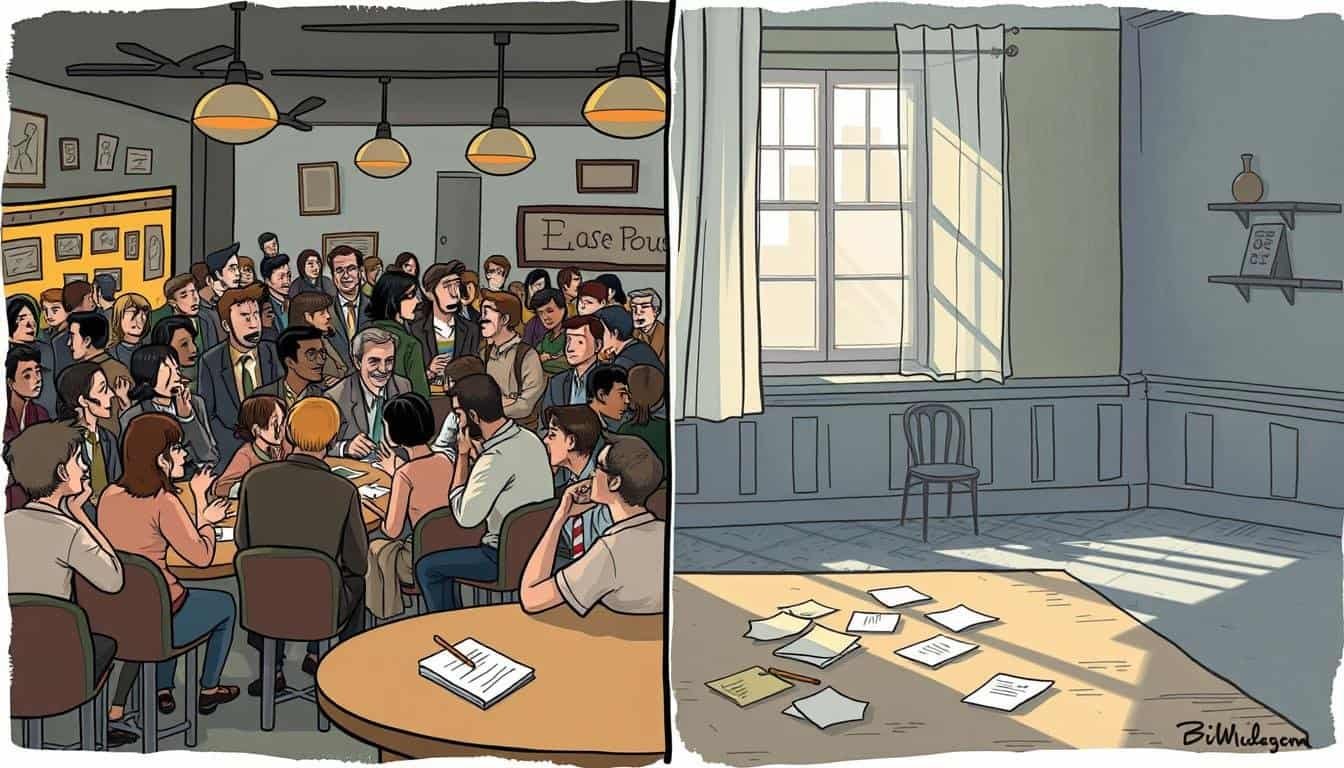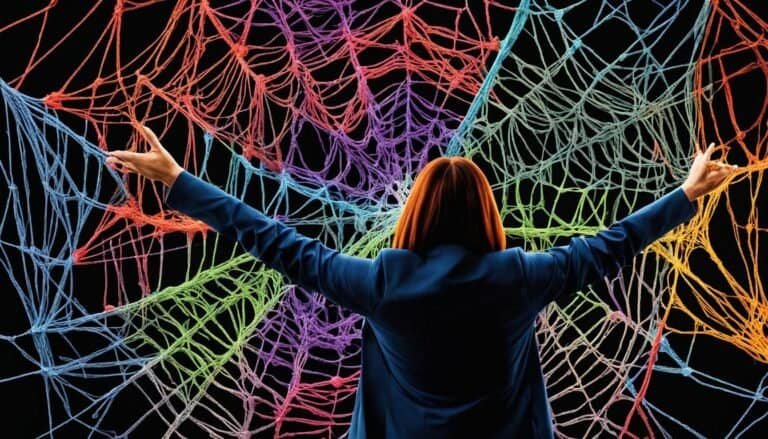Understanding The False Consensus Effect
Ever felt like everyone agrees with you? This feeling is known as the false consensus effect. It’s a common bias where people think more people share their views than they really do. This bias changes how we see our friends and affects big decisions in fields like social psychology, marketing, and how we talk to others.
In today’s world, with its many differing views, knowing about the false consensus effect helps us understand others better. It can lead to more empathy and better decisions in politics and our daily lives. It also helps us avoid misunderstandings and the trap of echo chambers online.
Key Takeaways
- The false consensus effect makes people think more people agree with them than they actually do.
- This bias can make political divisions worse and reduce empathy for others.
- Knowing about this effect helps us make smarter choices in our personal and work lives.
- It often creates echo chambers, especially on social media.
- Realizing our own biases can improve how we interact with others and lead to better social outcomes.
What is The False Consensus Effect?
People often think more people share their beliefs and actions than they really do. This makes them believe their views are widely accepted. It makes them feel their opinions are right and common.
This leads to a wrong idea of what others think and do. It makes people think their choices are more popular than they are.
Definition and Overview
At its core, the false consensus effect is about thinking more people agree with us than they actually do. It shows up a lot in social situations. People might think their friends’ opinions are what most people think.
This effect is also linked to motivated projection. Our own beliefs shape what we think others believe.
Historical Background
The study by Ross et al. in 1977 first brought up the idea of the false consensus effect. It started a wave of research into how people see themselves and others. They found people often see their actions as normal but others’ as unusual.
Later studies looked into how this effect works in different situations. Research by Botvin et al. and Leviston et al. showed how widespread this bias is. They looked at it in various groups and settings.
Key Characteristics of the False Consensus Effect
The false consensus effect shows how people often think more people agree with them than they really do. This bias changes how we see things, making us think our views are more popular. It affects how we talk to others, especially in groups where everyone thinks alike.
Cognitive Bias and Human Perception
Social psychologists Lee Ross, David Greene, and Pamela House found this bias in 1977. It’s clear in many areas, like business. For example, 80% of business leaders think their products are the best, but only 8% of customers agree. This shows how biased beliefs can affect decisions.
In schools, teachers might think all students like the same way of learning. This can make teaching less effective for everyone. Using feedback can help teachers see different opinions and teach better for all students.
Social Implications
This effect has big social impacts. In the 2016 U.S. election, social media made people only see views they agreed with. This led to surprises at the election results, showing how wrong views can shape opinions. In healthcare, doctors often think patients agree with their treatment plans more than they do, which can hurt communication.
This effect can stop deep discussions, making people less open to other views. Understanding and talking about these views can help build stronger communities and more open discussions in society.
Influential Factors Contributing to the False Consensus Effect
Exploring the false consensus effect shows us how our beliefs and social circles shape our views. It tells us how personal experiences and social interactions make us think more people agree with us than they actually do.
Motivational Processes
Motivational processes play a big role in how we see others’ beliefs. Many of us tend to think our beliefs are not only right but also widely accepted. This boosts our confidence and makes us feel our choices are correct.
Feeling like we share the majority’s views makes us more determined and encourages us to act in ways we think are normal. This is because we believe others think the same way we do.
Selective Exposure and Cognitive Availability
Selective exposure plays a big part in the false consensus effect. By hanging out with people who think like us, we limit our exposure to different opinions. This creates an echo chamber that distorts our view of how common our beliefs are.
Cognitive availability also adds to the problem. We remember examples that support our views more easily than those that don’t. This makes us think our opinions are more widespread than they really are.
Ambiguity Resolution Factors
When things are unclear in social situations, we often interpret others’ beliefs in our own way. This can make us think more people agree with us than they actually do. Unclear language in surveys can make this problem worse, leading to misunderstandings.
Our tendency to interpret things based on our own views can make us stick to our assumptions. This shows how clear communication is key to avoiding confusion.
Psychological Mechanisms Behind the False Consensus Effect
The false consensus effect shows how our minds play tricks on us. It’s about how we see our own actions versus others’. Salience, or what grabs our attention, is key. When we’re deeply into our beliefs or actions, we often think more people agree with us than they really do.
This selective focus makes us overlook different views outside our circle. It’s like we’re in our own bubble, not seeing the bigger picture.
Salience and Focus of Attention
People often think their opinions are more common than they are. This happens because we focus too much on our own experiences. We tend to ignore other viewpoints.
Laypeople might think their choices are widely accepted, seeing others’ different views as rare. This shows how we can be biased in seeing what’s common.
Logical Information Processing
How we process information affects our view of what others think. We use our own experiences to guess what’s common. This can lead to mistakes in understanding others.
Causal attribution makes it worse. If we think our actions are due to outside factors, we assume others feel the same. This can make us overestimate how many people share our views. Knowing about these biases is crucial for getting along with people who see things differently.
Real-World Examples of the False Consensus Effect
The false consensus effect happens in many places, like social media and debates on tough topics like climate change. On social networks, people often talk to others who think like them, making echo chambers. These echo chambers make people think their views are more common than they really are.
Social Media Influence
Social media is a big part of the false consensus effect. People choose to see content that matches their beliefs, so they rarely hear other views. This makes them think more people agree with them, especially on political issues. Research shows that heavy social media users often believe their views are more popular than they actually are, which can make them hold onto biased ideas.
Political Polarization and Climate Change Views
Climate change is a great example of how the false consensus effect leads to political division. People often think their views on climate change are more widely accepted than they really are. This belief stops meaningful talks between people with different views, making things more divided. Knowing about the false consensus effect is key to having better discussions and finding common ground.
How the False Consensus Effect Impacts Decision Making
The false consensus effect greatly influences how we make decisions in our daily lives. Many think their views are shared by most people. This can lead to choices that don’t match reality, causing poor outcomes.
Personal and Professional Decision Making
In personal life, like parenting, this illusion can cause us to overlook our child’s true needs. For instance, a parent might pick a popular sport for their child, thinking it’s what everyone likes. But this can make the child unhappy and uninterested.
At work, this effect can also play a role. Managers or designers might think a product is a hit just because they like it. This can lead to focusing on the wrong features, making decisions based on a wrong view of what users want.
Teams can also fall into this trap. When everyone agrees too much, decisions might not be the best. Having different views can lead to better ideas and a deeper analysis of problems. But, biases can stop this from happening.
| Cognitive Bias | Description | Impact on Decision Making |
|---|---|---|
| False Consensus Effect | Overestimating how much others share our beliefs | Leads to confirmation of personal choices, ignoring diverse opinions |
| Hindsight Bias | Believing outcomes were predictable after they occur | Causes individuals to underestimate the difficulty of new decisions |
| Dunning-Kruger Effect | Overestimating one’s ability in a given area | Results in poor task estimation, affecting quality of choices |
To beat these biases, we need to take steps. Reflecting on our choices and asking for feedback can help us see things more clearly. This way, we can make better decisions in our personal and work lives.
Group Dynamics and the False Consensus Effect
Group dynamics are key in shaping what we believe and think. In groups, the false consensus effect often happens. People stick to their views and ignore different opinions. This makes it hard for new ideas to come in.
The Role of Echo Chambers
Echo chambers form in tight-knit groups. People think most others agree with them. This feeling makes them less open to other ideas. Over time, they become less willing to hear opposing views.
Echo chambers can deeply affect how we make decisions. They make people less likely to talk openly or consider other sides. This can stop groups from growing and understanding complex issues well.
Groups and the false consensus effect can make beliefs more extreme. In echo chambers, people’s views can become distorted. This makes it hard to see different perspectives. As people cling to their groups, real conversations become less likely.
| Aspect | Echo Chambers | Open Dialogue |
|---|---|---|
| Engagement with Dissenting Views | Minimal | High |
| Acceptance of Shared Opinions | Strong | Variable |
| Cognitive Dissonance | Low | Encouraged |
| Innovation Potential | Limited | Enhanced |
The False Consensus Effect in Marketing and Business
The false consensus effect is key in marketing and business decisions. It makes marketers think more people share their views than they really do. For example, a study showed people often think others will choose the same as them, no matter what.
This shows up in marketing when companies launch products they think everyone will love. But, this isn’t always true.
Take Borders Books for instance. It was once a top bookseller but struggled starting in 2006 and closed in 2011. Poor decisions, partly due to the false consensus effect, led to its downfall. Marketing pros often assume others will like what they do, which can lead to wrong campaigns.
Market research is key to fight this bias. But, even with data, marketers might see it through their own eyes. A study found that trying to ignore personal likes can sometimes make things worse. Yet, being clear about your preferences can help avoid this bias.
Companies that think everyone agrees with them might lose some customers. This can hurt loyalty and how they keep customers. To fix this, companies should use data to understand what customers really want. Being open and showing they care about different views helps build trust with customers.
Knowing about the false consensus effect is crucial in many areas. In retail, offering a variety of products is important. In e-commerce, making things personal can make customers happier. By tackling this bias, marketers can make better choices and meet what customers want.
Why We Fall Victim to the False Consensus Effect
The false consensus effect comes from how our minds work. It makes us think more people agree with us than they really do. This happens because of three main reasons: thinking things are simpler than they are, comparing ourselves to others, and wanting to feel good about ourselves.
Cognitive Simplicity
Our brains like to make things simple. This means we often make quick decisions without looking at all the details. We might think others believe the same things as us, even when they don’t.
This makes us think our views are more popular than they actually are. It’s like we’re seeing the world through our own eyes, not really understanding what others think.
Social Comparison
Social comparison is a big part of who we are, says Festinger’s theory. We often check our own beliefs against those of others we feel are like us. This makes us want to be around people who think the same way as us.
So, we start to believe our views are more common than they really are. This makes us think everyone agrees with us, which isn’t true.
Self-Enhancement
We all want to feel good about ourselves. So, we might think others share our opinions to make ourselves feel better. This way, we feel validated and our self-esteem goes up.
But, this thinking can make us miss out on different opinions. We keep thinking everyone agrees with us, even when they don’t.
| Mechanism | Description | Impact on Decision Making |
|---|---|---|
| Cognitive Simplicity | Utilization of shortcuts in reasoning. | Overestimates shared beliefs. |
| Social Comparison | Evaluating one’s beliefs against peers. | Reinforces perceived consensus. |
| Self-Enhancement | Seeking validation of one’s beliefs. | Inflates self-esteem, distorts understanding of divergence. |
Systemic Effects of the False Consensus Effect
The false consensus effect has big impacts on society and culture. It makes people think more people share their views than they really do. This can trap groups in bad habits, keeping them from seeing new ideas.
In times of crisis, like water shortages, people don’t see others as helpful as they think. This leads to poor group actions.
Impact on Society and Culture
When it comes to big issues like climate change, this bias is clear. In places like China, the U.S., and Germany, people often think fewer support climate action. Australians also wrongly believe fewer agree with them on climate change.
This wrong thinking can stop people from working together. It makes them feel alone in their beliefs. This affects how we work together and act on big issues.
These biases stop progress and new ideas. When people think they’re in the majority, they’re less likely to question or think deeply. Fixing this bias is key to a more open and moving society. It helps in teamwork, marketing, and leadership, making culture better.







